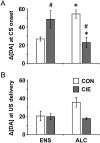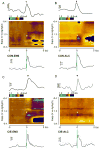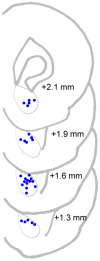Ethanol Exposure History and Alcoholic Reward Differentially Alter Dopamine Release in the Nucleus Accumbens to a Reward-Predictive Cue
- PMID: 29602178
- PMCID: PMC5984156
- DOI: 10.1111/acer.13636
Ethanol Exposure History and Alcoholic Reward Differentially Alter Dopamine Release in the Nucleus Accumbens to a Reward-Predictive Cue
Abstract
Background: Conditioned stimuli (CS) that predict reward delivery acquire the ability to induce phasic dopamine release in the nucleus accumbens (NAc). This dopamine release may facilitate conditioned approach behavior, which often manifests as approach to the site of reward delivery (called "goal-tracking") or to the CS itself (called "sign-tracking"). Previous research has linked sign-tracking in particular to impulsivity and drug self-administration, and addictive drugs may promote the expression of sign-tracking. Ethanol (EtOH) acutely promotes phasic release of dopamine in the accumbens, but it is unknown whether an alcoholic reward alters dopamine release to a CS. We hypothesized that Pavlovian conditioning with an alcoholic reward would increase dopamine release triggered by the CS and subsequent sign-tracking behavior. Moreover, we predicted that chronic intermittent EtOH (CIE) exposure would promote sign-tracking while acute administration of naltrexone (NTX) would reduce it.
Methods: Rats received 14 doses of EtOH (3 to 5 g/kg, intragastric) or water followed by 6 days of Pavlovian conditioning training. Rewards were a chocolate solution with or without 10% (w/v) alcohol. We used fast-scan cyclic voltammetry to measure phasic dopamine release in the NAc core in response to the CS and the rewards. We also determined the effect of NTX (1 mg/kg, subcutaneous) on conditioned approach.
Results: Both CIE and alcoholic reward, individually but not together, associated with greater dopamine to the CS than control conditions. However, this increase in dopamine release was not linked to greater sign-tracking, as both CIE and alcoholic reward shifted conditioned approach from sign-tracking behavior to goal-tracking behavior. However, they both also increased sensitivity to NTX, which reduced goal-tracking behavior.
Conclusions: While a history of EtOH exposure or alcoholic reward enhanced dopamine release to a CS, they did not promote sign-tracking under the current conditions. These findings are consistent with the interpretation that EtOH can stimulate conditioned approach, but indicate that the conditioned response may manifest as goal-tracking.
Keywords: Alcohol; Dopamine; Extinction; Naltrexone; Pavlovian.
Copyright © 2018 by the Research Society on Alcoholism.
Conflict of interest statement
Figures




Similar articles
-
Long-lasting contribution of dopamine in the nucleus accumbens core, but not dorsal lateral striatum, to sign-tracking.Eur J Neurosci. 2017 Aug;46(4):2047-2055. doi: 10.1111/ejn.13642. Epub 2017 Aug 1. Eur J Neurosci. 2017. PMID: 28699296 Free PMC article.
-
Cocaine Self-Administration Experience Induces Pathological Phasic Accumbens Dopamine Signals and Abnormal Incentive Behaviors in Drug-Abstinent Rats.J Neurosci. 2016 Jan 6;36(1):235-50. doi: 10.1523/JNEUROSCI.3468-15.2016. J Neurosci. 2016. PMID: 26740664 Free PMC article.
-
The tendency to sign-track predicts cue-induced reinstatement during nicotine self-administration, and is enhanced by nicotine but not ethanol.Psychopharmacology (Berl). 2016 Aug;233(15-16):2985-97. doi: 10.1007/s00213-016-4341-7. Epub 2016 Jun 9. Psychopharmacology (Berl). 2016. PMID: 27282365 Free PMC article.
-
Dopamine signaling in the nucleus accumbens of animals self-administering drugs of abuse.Curr Top Behav Neurosci. 2010;3:29-71. doi: 10.1007/7854_2009_27. Curr Top Behav Neurosci. 2010. PMID: 21161749 Free PMC article. Review.
-
Pavlovian sign-tracking model of alcohol abuse.Curr Drug Abuse Rev. 2013 Sep;6(3):201-19. doi: 10.2174/18744737113069990023. Curr Drug Abuse Rev. 2013. PMID: 24694108 Review.
Cited by
-
Behavioral, neurobiological, and neurochemical mechanisms of ethanol self-administration: A translational review.Pharmacol Ther. 2020 Aug;212:107573. doi: 10.1016/j.pharmthera.2020.107573. Epub 2020 May 11. Pharmacol Ther. 2020. PMID: 32437827 Free PMC article. Review.
-
Evidence for incentive salience sensitization as a pathway to alcohol use disorder.Neurosci Biobehav Rev. 2019 Dec;107:897-926. doi: 10.1016/j.neubiorev.2019.10.009. Epub 2019 Oct 28. Neurosci Biobehav Rev. 2019. PMID: 31672617 Free PMC article. Review.
-
Acute depletion of dopamine precursors in the human brain: effects on functional connectivity and alcohol attentional bias.Neuropsychopharmacology. 2021 Jul;46(8):1421-1431. doi: 10.1038/s41386-021-00993-9. Epub 2021 Mar 16. Neuropsychopharmacology. 2021. PMID: 33727642 Free PMC article.
-
Ampicillin/Sulbactam Treatment Modulates NMDA Receptor NR2B Subunit and Attenuates Neuroinflammation and Alcohol Intake in Male High Alcohol Drinking Rats.Biomolecules. 2020 Jul 10;10(7):1030. doi: 10.3390/biom10071030. Biomolecules. 2020. PMID: 32664441 Free PMC article.
-
Recruitment and disruption of ventral pallidal cue encoding during alcohol seeking.Eur J Neurosci. 2019 Nov;50(9):3428-3444. doi: 10.1111/ejn.14527. Epub 2019 Aug 19. Eur J Neurosci. 2019. PMID: 31338915 Free PMC article.
References
-
- Badanich KA, Maldonado AM, Kirstein CL. Chronic ethanol exposure during adolescence increases basal dopamine in the nucleus accumbens septi during adulthood. Alcohol Clin Exp Res. 2007;31:895–900. - PubMed
-
- Bath BD, Michael DJ, Trafton BJ, Joseph JD, Runnels PL, Wightman RM. Subsecond adsorption and desorption of dopamine at carbon-fiber microelectrodes. Anal Chem. 2000;72:5994–6002. - PubMed
Publication types
MeSH terms
Substances
Grants and funding
LinkOut - more resources
Full Text Sources
Other Literature Sources

